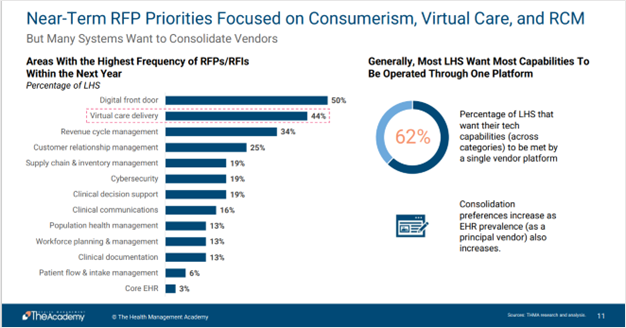
Budgetary constraints and staffing challenges are compelling healthcare organizations to rethink their operational strategies to find new ways for burned-out care teams to work smarter, not harder.
One strategy that providers are employing to drive efficiency, standardize processes, and elevate the standard of care in inpatient settings is the adoption of hybrid care models. These care models introduce remote clinicians and digital health tools at the bedside. Leading health systems such as Houston Methodist, OhioHealth, and UMass Memorial Health are among those planting the first “smart hospital” and “hospital of the future” flags, introducing high-end technologies in every patient room.
As healthcare organizations bring telehealth, artificial intelligence (AI), interactive patient consoles (IPCs), and other health IT resources to the hospital bedside, the race for a space on the patient footwall is heating up. And hospitals looking to differentiate themselves and improve operations through the adoption of innovative technologies are rightfully being more discerning in their product evaluations.
Increasingly, providers are favoring a platform approach to underpinning infrastructure in an effort to keep solution sprawl and fragmentation at bay. Recent research from the Health Management Academy reveals that 62% of leading health systems want their tech capabilities (across categories) to be met by a single vendor.

Signify Research similarly observed a shift in provider preferences towards solutions that cater to broader use cases. “Historically, endpoint solutions have been departmental, siloed, point-focused products (hardware-centric), however, enterprise-scale solutions with a focus on platform-centric and configurable workflows have become increasingly prominent.” Continuous monitoring solutions are cited as a prime example of this shift from point solutions to comprehensive platforms that not only centralize but also simplify resource administration and management.
The ability of bedside technology to integrate seamlessly with existing hospital systems, especially the Electronic Health Record (EHR), is crucial for securing a coveted spot on the patient footwall. A platform’s ability to seamlessly integrate with a broad spectrum of peripheral systems further supports consolidated solutioning, allowing care teams to pilot adjacent technologies more easily.
Case in point: In the realm of virtual care, new telehealth edge devices like Caregility’s APS200 Duo enable healthcare organizations to introduce AI capabilities using the same device that supports audio and video feeds used for virtual patient engagement and observation. The device’s ability to integrate with IPCs and smart TVs in the patient room allows care teams to leverage existing technology investments during implementation.
As healthcare institutions continue to integrate advanced technologies into care delivery, the importance of unified, platform-based solutions becomes ever more apparent. This strategic approach not only simplifies infrastructure but also significantly boosts care teams’ ability to deliver personalized, efficient, and high-quality care at scale.
Interested in learning more about how hospitals are leveraging enterprise telehealth and IPC platform integrations to support forward-thinking care initiatives? Join clinical experts from OhioHealth, Vibe Health, and Caregility for the webinar “Clinical Workflow Optimization: The Role of Virtual Nursing” taking place on Thurs., Feb. 8, from 2-3 pm EST.







